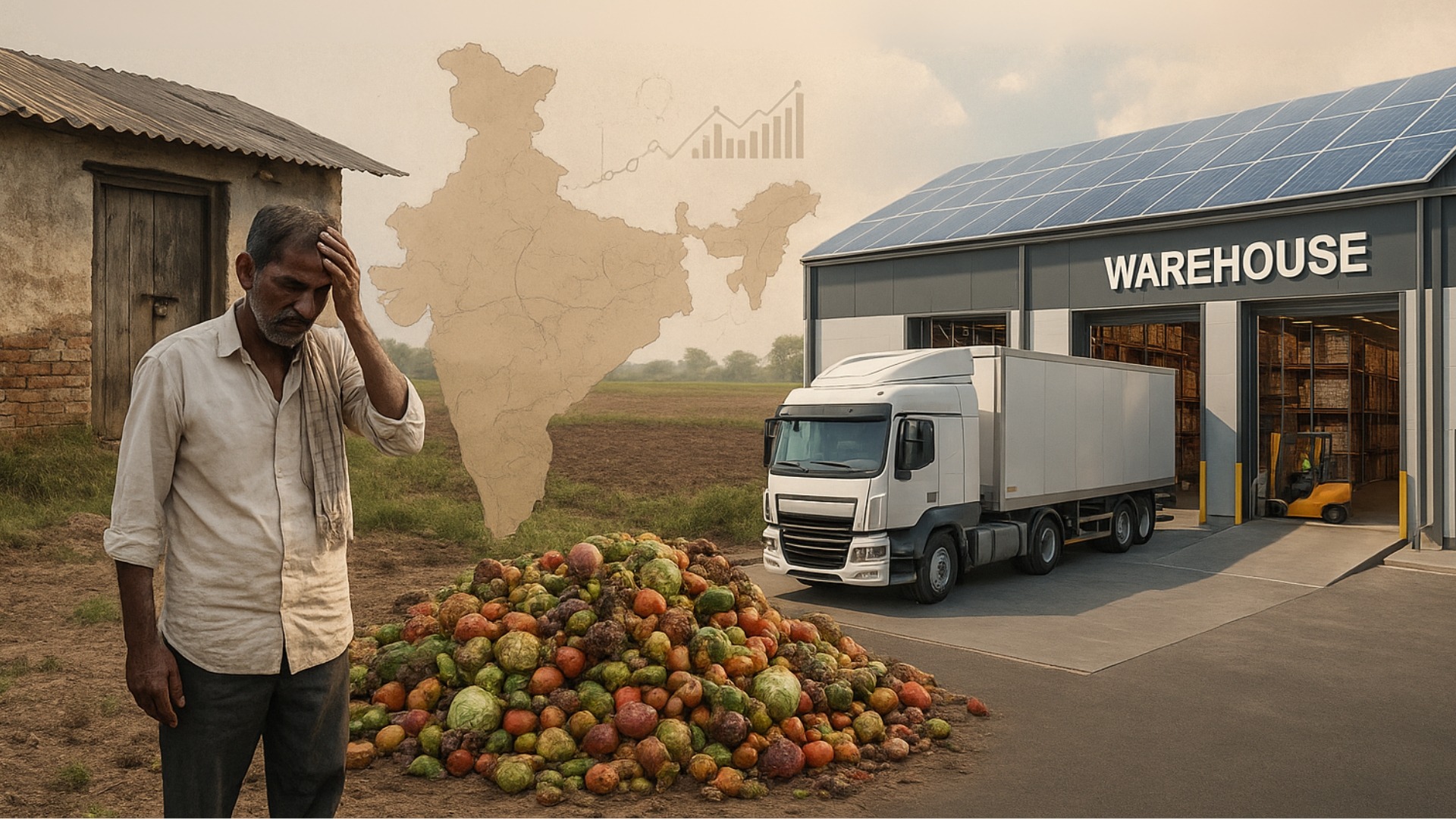A few days ago, the world watched as India officially surpassed Japan to become the 4th largest economy, with a GDP of $4 trillion, as per the latest IMF data. This milestone is a clear signal that India is on a fast track toward becoming a $5 trillion economy.
But here’s the catch: while we chase that next big number, there’s a silent crisis growing in the shadows, quietly eating away at our economic momentum. If we could solve that, it would be a game changer.
Let’s zoom out for a second.
Imagine a small town 100 kilometres from a Tier-1 city like Hyderabad, Bengaluru, or Mumbai. Take any part of the country, North to South, East to West, and you’ll likely see the same picture: fertile agricultural lands, industrial parks, processing mills, and local manufacturing units.
When you observe all of this, you will find a missing critical piece. Any guess? It is probably the biggest problem India has had for a long period, even today.
The Problem Isn’t Production. It is storage.
A farmer harvests high-quality onions but finds no cold storage within 50 kilometers; because of that, his crop spoils, or he sells it for pennies.
A pharma company transporting temperature-sensitive vaccines loses ₹5 crore worth of inventory due to unreliable warehousing.
A fast-scaling e-commerce startup finds its last-mile delivery costlier than its profits, resulting in many startups in this space incurring losses.
Yes, many startups and logistics players are throwing resources at solving last-mile delivery. But even that’s not the core issue.
The real problem?
It is warehousing and storage infrastructure, the invisible backbone that supports every other industry, yet remains fractured, under-invested, and inefficient.
From storing the agricultural produce to the pharma medicines, FMCG, e-commerce, apparel, chemicals, fertilizers, or even any product that needs to be stored there is a huge gap that needs to be filled.
How big is that problem, and who is solving it?
Let’s understand the scenario first:
According to data released by the Union Ministry of Food Processing Industries, India incurs an estimated loss of ₹1.5 lakh crore annually due to post-harvest inefficiencies.
This loss primarily comes from the lack of adequate storage infrastructure, inefficient transportation, and poor logistical support across the agricultural supply chain.
According to a detailed study by NABARD Consultancy Services (NABCONS):
- Cereals such as rice, wheat, and maize account for an annual loss of over ₹26,000 crore.
- Pulses and oilseeds contribute to additional losses amounting to approximately ₹18,000 crore.
- The most staggering losses come from fruits and vegetables, accounting for nearly ₹57,000 crore every year.
Diving deeper:
- Bananas: ₹5,777 crore lost.
- Mangoes: ₹10,851 crore lost.
- Citrus fruits: ₹4,347 crore lost.
These numbers highlight a harsh reality: India is losing thousands of crores worth of agricultural produce not due to poor production, but because of inadequate storage, cold chain, and transport infrastructure.
Imagine the business opportunities, farmer incomes, and export potential we’re missing out on simply because of post-harvest inefficiencies.
This problem is not limited to the agriculture industry. Every industry in the country needs storage and warehousing infrastructure.
The demand for warehouses is rising, According to estimates:
- The Indian warehousing market is predicted to reach US$ 34.99 billion, growing at a CAGR of 15.64% by 2027.
- India’s total warehouse space is expected to reach 1.2 billion square feet by 2027.
Indian warehouses are classified into three types: Grade A, B, and C.
- Grade A warehouses are modern, high-specification warehouses that meet global standards. Preferred by big corporations, e-commerce giants, and 3PL players. Ideal for sectors like e-commerce, pharmaceuticals, FMCG, electronics, and automotive.
- Grade B are conventional warehouses developed in an unorganized manner. Commonly used by small traders, agro-commodity dealers, and MSMEs in rural and semi-urban areas.
Reality check:
Grade A warehouses make up a small portion of India’s warehousing capacity, concentrated around metro cities.
Approximately 90% of India’s warehousing space is controlled by unorganised players predominantly comprising Grade B and lower-grade facilities.
These warehouses are typically small-sized (often <10,000 sq. ft.), with limited mechanization and modern infrastructure.
This reflects inefficiencies, high spoilage rates, and significant economic value lost particularly across agriculture and rural manufacturing.
So, if the problem is so large, why aren’t more players solving it?
And what is the government doing?
Few Key Players Addressing the Gap:
- Arya.ag – Integrated warehousing, farm-gate storage, and value chain solutions.
→ Manages 12,000+ warehouses, storing over \$3B worth of grains annually. - IndoSpace – India’s leading developer of Grade A logistics parks.
- DeHaat – Full-stack agri-tech with integrated warehousing and logistics.
- LEAF – End-to-end solutions for fruits and vegetables, including cold chain.
- Ecozen – Solar-powered cold storage for rural/off-grid farming.
- Tan90 – Affordable thermal energy-based cold chain solutions.
- Ninjacart – Agri-supply chain platform focusing on decentralized storage.
- Samunnati – Agri-fintech supporting FPOs with infra and financing.
Despite these efforts, Grade B and unorganized warehouses still account for 70–75% of total infrastructure, particularly in agri belts.
Companies like Mahindra Logistics, Allcargo Logistics, Welspun One, WayCool, ESR, and Coldman Logistics are building assets, yet demand far exceeds current supply.
Challenges in Warehousing & Cold Chain Infrastructure:
- High Capital Requirements – Land, tech, and infra are expensive.
- Land & Location Constraints – Scarcity of suitable, well-connected land.
→ Land acquisition accounts for 40–45% of total cost. - Lower Returns vs. Commercial Real Estate – Warehousing yields 8–10% returns.
- Fragmented, Seasonal Demand – Inconsistent, harvest-based demand in rural areas.
What is the Government Doing?
- PM Gati Shakti – National plan integrating logistics, warehousing, highways, and corridors.
- Warehousing Act – Regulating and improving storage infra standards.
- Gramin Bhandaran Yojana – Subsidies for rural warehousing.
- Agriculture Infrastructure Fund (AIF) – ₹56,334 crore sanctioned for 92,000+ agri projects since 2020.
In 2024 alone, India’s logistics and warehousing sector attracted $2.5 billion in private investment.
Still, it’s not enough to solve the crisis. India can’t become the largest economy on broken supply chains. This is our silent emergency and a Trillion-dollar opportunity.
A Call to Action for Startups:
Instead of burning millions on user acquisition, discounting, or building yet another app with no real impact, India’s startup ecosystem must focus on meaningful infrastructure plays.
The demand is real. The gap is visible. The potential is massive.
It’s time to innovate where it truly matters: in agri-supply chains, cold chain logistics, and rural infrastructure.
Also Read: India Startup Funding 2025 Surges to $3.1B as AI and Deeptech Attract VC Attention








